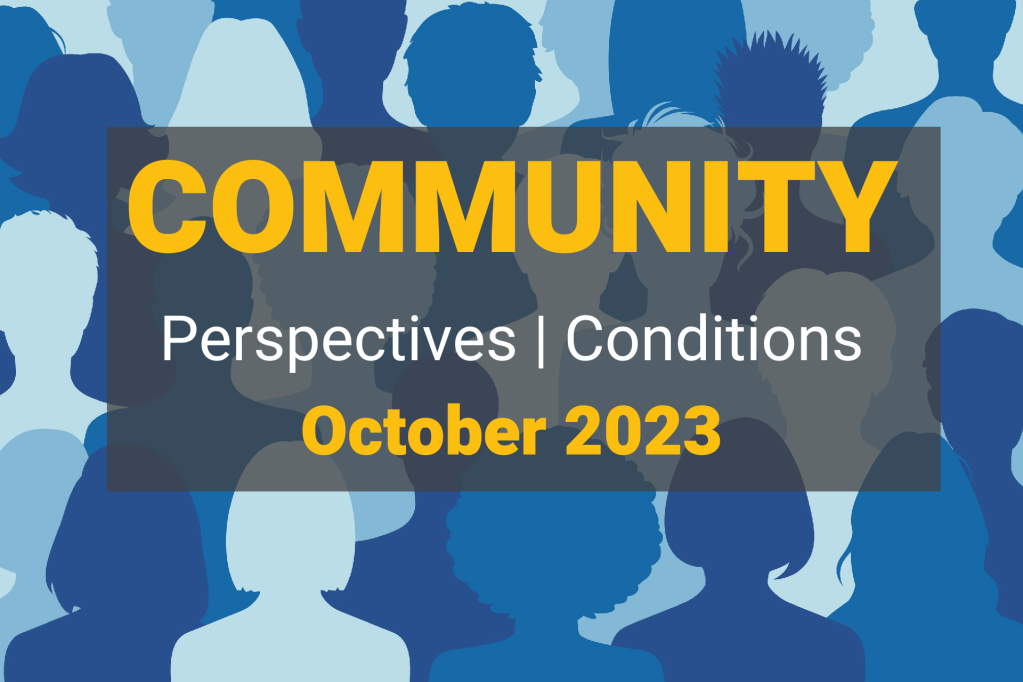Federal Reserve Banks across the country collect anecdotes from contacts and hone in on concerns for Federal Reserve Beige Book summaries, published eight times each year. Historically, insights about conditions affecting low- and moderate-income communities have come from the perspective of businesses. Several Reserve Banks began including “Community Conditions” and “Community Perspectives” sections last fall. These sections provide insight into local changes through direct accounts of nonprofit and community leaders and workforce professionals serving lower-income people. Here are some takeaways from the October 2023 Beige Book, which was prepared at the Federal Reserve Bank of St. Louis and based on information collected on or before October 6, 2023.
Please note that the Beige Book summarizes comments received from contacts outside the Federal Reserve and is not a commentary on the views of Federal Reserve officials.
“Community and education leaders around the District reported significant challenges with staffing shortages in schools. Teacher vacancies are higher this fall than in past years, particularly for math, world languages, and English as a new language. Additionally, key personnel such as counselors, librarians, school bus drivers, food service workers, and custodians are in low supply, placing increased pressure on existing staff and reducing the quality of the services provided. Financial pressures have mounted due to the combination of increased services, rising educational needs of the children of asylum seekers, and the winding down of federally provided pandemic relief funds.”
– New York Fed, Federal Reserve 2nd District, Community Perspectives
“Nonprofit contacts noted that small businesses and low- and moderate-income households experienced declines in credit access, while the latter also saw affordable-housing conditions deteriorate over the past six months, according to a semiannual survey. Several contacts said higher interest rates and tight credit requirements impacted businesses’ and households’ ability to qualify for loans. One contact indicated that businesses with long-standing banking relationships had difficulty securing traditional financing. Rising rents and a shortage of affordable housing continued to impact low- and moderate-income households’ ability to secure housing. Moreover, some landlords stopped accepting housing choice vouchers in order to get higher rents in the open market.”
– Cleveland Fed, Federal Reserve 4th District, Community Conditions
“Community, nonprofit, and small business contacts reported little change in economic activity from a robust level. State government officials saw some decline in tax revenues but low demand for unemployment insurance continued. Small business owners said tight labor markets were hampering growth and that they were reluctant to pursue expansions, in part because of tighter credit conditions. Nonprofit contacts reported that a limited supply of lower end housing was contributing to rising rents and straining household budgets. In addition, there were long waiting lists for prospective tenants at some places. Contacts noted that in some smaller municipalities limited options for housing and childcare were undermining efforts to attract and retain workers.”
– Chicago Fed, Federal Reserve 7th District, Community Conditions
“Contacts reported that low- and moderate-income (LMI) workers continued to pursue higher wages through job hopping, but those opportunities were becoming less advantageous. Entry-level wages have continued to rise, though at a much slower pace than a few months ago. Most workforce organizations said they focused on directing clients to seek more career-oriented opportunities in preparation for a possible recession. However, clients have been hesitant to pursue such opportunities due to the time they would need to spend in training, favoring more immediate employment. Workforce organizations reported seeing more LMI individuals pursuing work despite ongoing challenges reaching employer locations and finding childcare. One organization with a harder-to-place clientele reported placement rates fell to a multi-year low of 30 percent, citing higher rates of addiction, mental health issues, and physical disabilities.”
– Kansas City Fed, Federal Reserve 10th District, Community Conditions
“Demand for nonprofit services remained elevated. Affordable housing was a pressing concern, and one nonprofit said they received additional housing assistance funding but were constrained by the limited number of landlords willing to accept housing vouchers. Another contact noted that inflation continued to squeeze households’ food budgets, putting healthier food options out of reach. One nonprofit reported they often had a two-to-four-hour line at their food pantry. Several contacts expressed concern over the ending of pandemic era relief funds, particularly for childcare centers. Multiple daycare centers have already announced closures, with one nonprofit leader noting that the impact to affected families is “catastrophic,” as there aren’t other options in the area. Some local workforce boards were proactively enrolling childcare centers into the state childcare subsidy program and mentoring them, with the hope of providing more options for low-income families.”
– Dallas Fed, Federal Reserve 11th District, Community Perspectives
“Demand for community and support services remained elevated. In particular, households and community members sought support for house affordability, food assistance, rental assistance, childcare, and mental health services. Nonprofit organizations continued to report notable drops in funding and charitable donations, which further constrained their ability to meet demand for basic needs. Some contacts highlighted the negative impact on housing affordability from the ongoing transformation of many old residential properties to newer upscale units in urban areas across the District.”
– San Francisco Fed, Federal Reserve 12th District, Community Conditions
Visit the October 2023 Beige Book report for a full national summary and more information about economic conditions from each Reserve Bank, including labor markets, financial services, real estate, and more.




